by Erika Steensma | Apr 23, 2020
It looked like any of the number of procedural rooms that I had been in during the past four years of medical school. Behind a glass partition, there were rows of medications ranging from blood pressure drugs to birth control pills, many of which I had seen prescribed to my own patients. There was an x-ray machine in the corner, and a CT machine waiting next door. Various pieces of ventilating equipment were neatly stacked in metal bins and shelves lining the walls. It looked so familiar, that I could almost forget the reality: I was at the Detroit Zoo, and all of these medications and equipment were used to treat the exotic animals that reside there.
It was for this very reason–to understand the connections between human and animal health–that my classmate Kate Heckman and I developed a Comparative Medicine elective for upperclass medical students to take during their time in the Branches. The idea for comparative medicine, defined as the study of similarities and differences between animal and human medicine, is not new. It has been endorsed by famous physicians ranging from the historic Hippocrates to the more recent Dr. Virchow (who is known as “the father of modern pathology”). In fact, even the Center for Disease Control promotes the One Health Initiative, which aims to increase collaboration between physicians, veterinarians, and other health professionals.
Although there was a strong academic precedent for creating the course, I had a slightly different motivation in developing this elective. Growing up, I always had a wide range of academic interests. However, once in medical school, I was quickly overwhelmed by the sheer volume of information available for a medical student to study. Worried that I would be an incompetent physician if I did not commit to learning as much of it as possible, I focused all of my energy and time on studying human physiology, anatomy, and medicine; gradually, all of my other academic interests and passions fell to the wayside. I was worried that I was coming out of medical school less curious and less creative than I was when I started. The idea of developing a course in a field that interested me, but had little exposure to in medical school, seemed like the perfect opportunity to return to my roots and rekindle my passion for learning.
Although Kate and I had no prior experience with course development, we were mentored by Drs. Fox and Alsup, faculty within the medical school anatomy program, who helped us with the paperwork and administrative process of gaining course approval. Dr. Nemzek, a faculty member at the University of Michigan’s Unit for Laboratory Animal Medicine (ULAM) assisted us with curriculum development and connected us with various field experts for course lectures. Furthermore, with grant funding from the Medical School, we were able to cover the costs of educational sessions arranged at the Detroit Zoo and Michigan State University Veterinary School as well as fund a pet CPR certification course for students enrolled in the course. All of this exemplifies our Medical School’s approach to student-led projects; not only does Michigan encourage students to pursue their interests, but it provides the support and resources necessary to help them succeed.
In planning the lecture portion of our course’s curriculum, we found numerous physicians who, on top of their expertise in human medicine, had strong background knowledge in animal medicine and physiology. Our lectures included a discussion of how brain structure varies between species, and how this correlates to animal behavior led by Dr. Selwa, a neurologist. Dr. Green, an otolaryngologist, spoke on animal pharynx structure compared to human anatomy, explaining why humans can talk while other animals can’t. An emergency medicine physician held a Jeopardy-style trivia competition to teach about management of animal bites and stings. I was especially impressed that many of these lecturers studied comparative physiology and medicine on their own time, purely for their own interest. I was reassured to realize that being a good physician does not necessitate purely focusing one’s attention on human medical journals and literature.
However, my favorite parts of the course were the experiential learning trips that we arranged within the University of Michigan as well as community organizations and other academic centers. At Michigan, we visited the Unit for Laboratory Animal Medicine, where we learned about the ethics of animal research, the contributions that animal-based research has made to our understanding of human disease and medical care as well as the strengths and weaknesses of our current animal models of disease. I was pleasantly surprised to learn about the extent of research and effort that veterinarian staff at ULAM employ to give their animals a good quality of life, including strategies to provide social and intellectual enrichment.
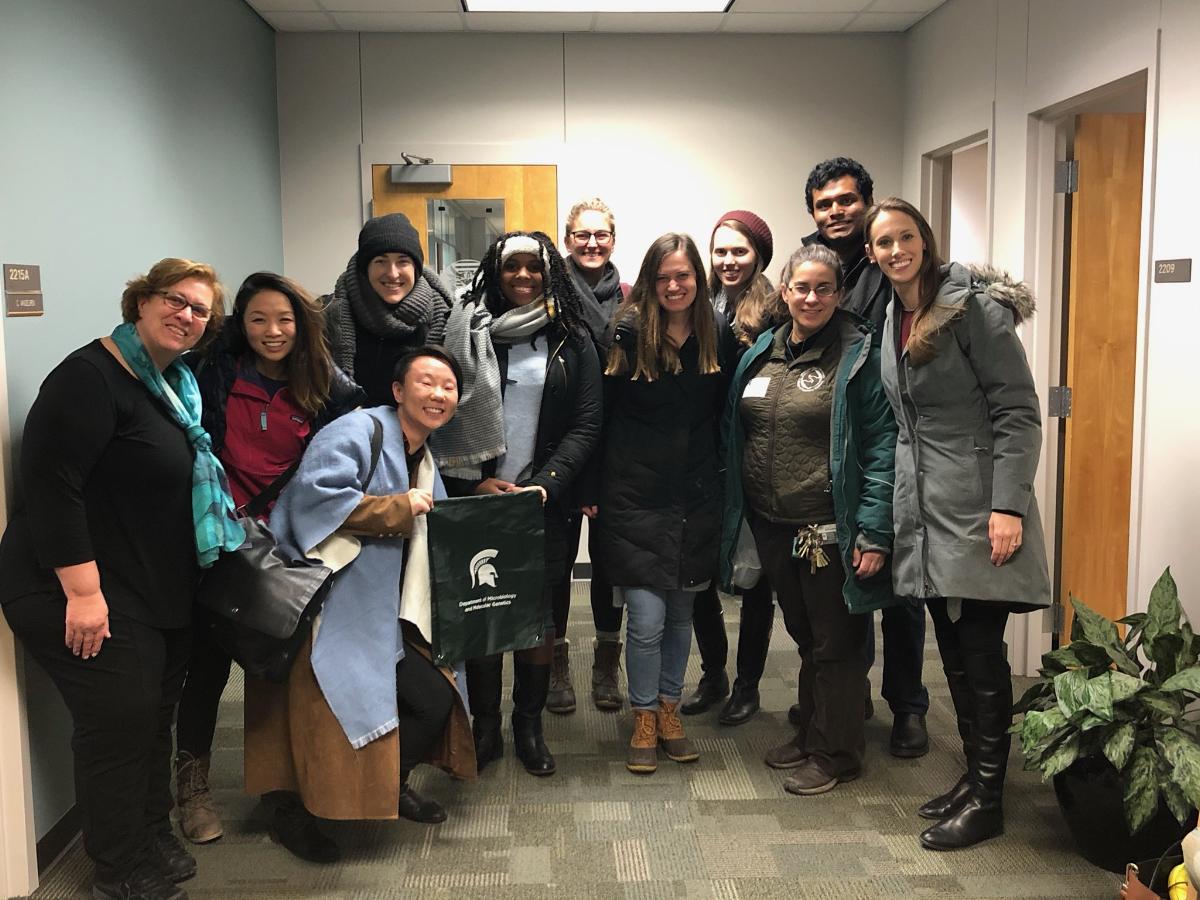
We loved having the opportunity to learn from the veterinary experts at Michigan State University!
We also arranged a trip to the highly renowned Michigan State University School of Veterinary Medicine. We were given a tour of the facilities and learned about innovations in animal medicine that could potentially lead to development of new treatments for human diseases in fields such as oncology and ophthalmology. At the anatomy lab, we were tested with labeling the joints of a full-scale horse model. As we struggled through the exercise, asking questions such as “Do horses have elbows… or are they just called ‘front knees?”, I was struck both by how limited my knowledge base in comparative anatomy was, and yet how many correlations there are between the bones and anatomical structures of a horse and those of a human (I also learned that the “front knee joint” is actually called the carpus). Most of all, I was impressed by the enthusiasm of the staff and faculty at the Veterinary School in teaching medical students. They shared their delight in the course and expressed the value that they felt could be gained by further collaboration between our two fields, and by this point in the course, I could not help but agree.
Our course ended with an afternoon spent with Dr. Duncan, the director of veterinary medicine at the Detroit Zoo. She gave a brief talk on the Zoo’s program for maintaining heart health in the great apes, during which I was surprised to discover that the heart disease processes that gorillas face are similar to those I had seen in many of my patients at the hospital, as were the treatments–although I have never had to sneak medications to my patients through juice boxes, as the veterinary staff do. We were then given a tour of the procedural facilities, where animals are given physical exams and are treated for various ailments. Once again, my classmates and I were amazed at the degree of overlap in the equipment and medications used at our hospital and here at the zoo. We also learned that, for animals with complex or highly specific disease processes, zoo veterinarians often consult their human medicine counterparts with expertise in the disease to help with management and treatment of the animals. It was a career opportunity that few of us realized existed, and many of us resolved to take part in someday.
During the yearlong process of developing the comparative medicine course, the question that I most frequently received from classmates, family, and friends was “why?” Why should medical students spend their time learning about animals, when there are so many human medicine topics to study? At the time, I would fumble for a response, mumbling something about “gaining a background for research” and “expanding our knowledge base.” But now, I would argue, why not? I came to medical school worried that if I didn’t focus all of my attention on human medicine, I would become a worse physician in the future. As I look forward to graduating in one month, I realize that the effect is actually the opposite. By taking time during my third and fourth years of medical school to explore my interests in narrative writing and comparative medicine, I have not only become a more well-rounded student, but I have found myself asking more questions, reading more books, and most importantly, enjoying learning and studying once again. Exploring passions that lie outside of strictly human medicine can allow for medical students and physicians to retain the curiosity and passion that allowed them to succeed academically, and will continue to serve them in their care of patients.
by Ruth Bishop | Apr 17, 2020
There was a certain foreboding quietness in the wards during the weeks before the onslaught of COVID-19. With classes canceled for pre-clinical medical students and most elective surgeries or non-urgent clinic visits rescheduled, the hospital, which often functions at full-capacity, seemed empty. Besides more masked faces roaming the corridors and checkpoints at all the hospital entrances with guards asking, “Do you have symptoms of cough, cold, or flu?”—not much looked differently from days before COVID-19 made its way to our state. However, the entirety of Michigan Medicine felt very different.
As a clinical medical student, my classmates and I have felt a certain tension between our role as learners and wanting to be on the front lines during this time of crisis. We want to be in the hospital, yet we also do not want to get in the way. Is our presence within the hospital space as learners an asset to reduce burden on nurses and physicians as they provide care to COVID-19 patients, or are we using up valuable PPE and being agents of viral spread? On March 17, the Association of American Medical Colleges and Liaison Committee on Medical Education decided the latter, issuing a statement recommending that medical schools pause all clinical rotations until at least the end of the month. Within minutes of this announcement, a dismissal email from the deans was in our inboxes.
In being removed from the clinical setting, I felt denied the great privilege that the health care profession bestows: to serve others in moments of crisis. I personally believe that medical students can be useful; we just need the appropriate training and direction. We can do ‘scut work,’ like calling consults, writing notes, or admitting non-COVID19 patients, freeing up more time for residents and physicians tending to the unfolding crisis. While I agree we are not yet equipped to be essential personnel at the front lines, I believe that the opportunity to volunteer in some capacity in the clinical space should be open to us. We, too, have an ethical responsibility to patients. We took a pledge at our white coat ceremony saying so.
The outbreak has underlined the health care system’s lack of preparedness on many fronts—particularly in providing appropriate resources to vulnerable patient populations and health care providers who are still expected to go to work. While schools and daycares are sending kids home, parent doctors and residents are scrambling to find childcare. Additionally, there have been little to no guidelines regarding how to best protect certain patient populations, such as people experiencing homelessness, who have nowhere to safely practice social distancing. These challenges are just in addition to concerns surrounding availability of PPE, ventilators, and our blood supply.
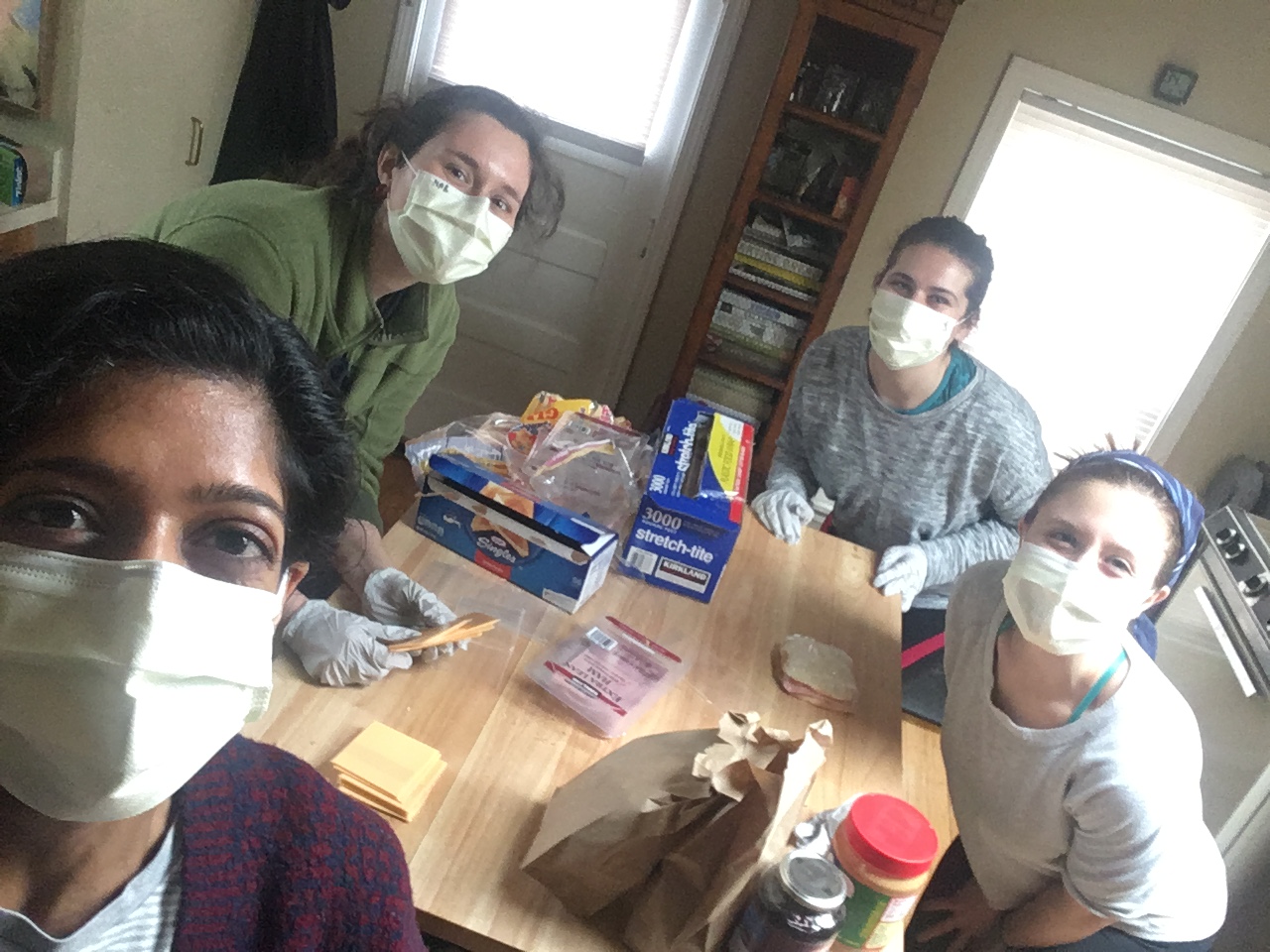 Since being dismissed from the clinical space, my classmates and I have been mobilizing to address some of these gaps and support our disrupted community. We have become babysitters for physician residents and grocery shoppers for our elderly neighbors. We have been calling local home improvement stores to collect PPE and staffing blood drives and COVID-19 hotlines. We even made our own bottles of hand sanitizer from scratch and assembled hundreds of sack lunches in a classmate’s apartment for distribution at local homeless shelters. Medical students may not be allowed on the front lines, so for now we have assumed a role on the home front, serving and organizing at a distance, awaiting the day when we are called back to work.
Since being dismissed from the clinical space, my classmates and I have been mobilizing to address some of these gaps and support our disrupted community. We have become babysitters for physician residents and grocery shoppers for our elderly neighbors. We have been calling local home improvement stores to collect PPE and staffing blood drives and COVID-19 hotlines. We even made our own bottles of hand sanitizer from scratch and assembled hundreds of sack lunches in a classmate’s apartment for distribution at local homeless shelters. Medical students may not be allowed on the front lines, so for now we have assumed a role on the home front, serving and organizing at a distance, awaiting the day when we are called back to work.
Addendum: Since writing this, select medical students have been allowed back into the clinical space on a volunteer basis to work as respiratory therapy extenders and discharge support on internal medicine services.
by Ione Locher | Apr 13, 2020
Hi, I’m Ione and I’m writing today about the six-month Henry Ford Health System (HFHS) rotation block!
I initially decided to participate in the Henry Ford Health System rotation block because I had come to medical school knowing that I wanted to engage deeply with health disparities, and I wanted to make health disparities a focus of my M3 Branches curriculum. Although I’ve loved my rotations at UofM, I knew I would learn some different lessons about health disparities by rotating at HFHS, and especially at the HFHS main hospital, which is a safety net hospital serving the Detroit area. I applied to participate over the summer of my M2 year, and started my first rotation in January of my M3 year.
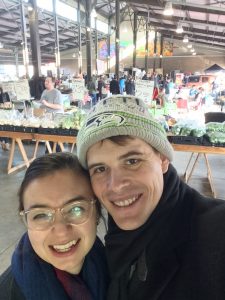
Exploring Eastern Market in Detroit! On Saturdays, Eastern Market hosts an enormous farmers’ market. One Sunday every May, Eastern Market hosts “Flower Day,” which is a huge farmers’ market all for flowers.
For my six months at HFHS, I moved to Detroit and lived on campus at Henry Ford Hospital in an apartment building especially for students and residents. I had six, one-month rotation blocks: one month each of Ambulatory Care, Labor and Delivery, Trauma Surgery, and the Medical ICU, and two research blocks.
My rotations at HFHS spanned a broad spectrum of clinical care contexts. I found that on each of the services at HFHS, I learned something different about how clinicians are working to meet the health needs of the city of Detroit. For example, on my Ambulatory Care rotation, I spent time at four different Federally Qualified Health Centers around the city of Detroit. On this rotation, I learned a lot about just how diverse FQHCs can be with huge variation in organizational structures, challenges at each clinic, funding streams, and patient populations. (I also met many inspiring clinicians passionate about delivering great primary care during this rotation!)
My Labor and Delivery rotation taught me a lot about the migration patterns that are bringing young people and families to Detroit right now: I routinely met patients from Mexico and Latin America, as well as Yemen, Lebanon, Syria, and Bangladesh, and I gained a better appreciation of the specific needs of immigrant patients. Each of these rotations taught me something different about health disparities, and efforts to address and reduce health disparities, in the context of Detroit.
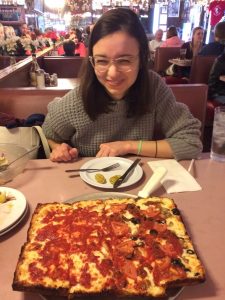
Trying out Detroit Style Pizza!
Living in Detroit was itself another amazing part of the HFHS rotation block! Students who had completed this rotation before me gave me a list of great things to do to explore Detroit. While I was there, I added my own favorite places to the list. For anyone wanting to learn more about Detroit, here’s a list of recommendations:
Food:
Taqueria el Rey
Mi Pueblo
Detroit Vegan Soul
Cedarland (Dearborn)
Ima
Pie Sci
Eater Detroit (great food blog about the restaurant scene in Detroit)
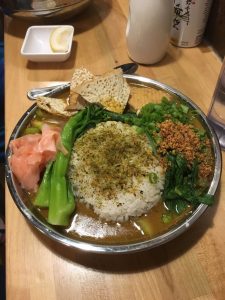
Golden Curry at Ima! So so tasty. I also very much recommend the ramen!
Drinks:
Flowers of Vietnam
Chartreuse
Culture:
DIA
Detroit Historical Society
Heidelberg Project
Motown Museum
Detroiters Speak lecture series
Eastern Market
Dequindre Cut Parkway
Still on my list of places to visit/try:
Rose’s Fine Foods
Sweet Potato Sensations
Bonoful Sweets & Cafe
Dabls MBAD African Bead Museum
Detroit Soup (Microgranting Dinner)
Baker’s Keyboard Lounge (Jazz Lounge)
Got other great recommendations of things to do in Detroit?? I’d love to hear them! Email me at ilocher@umich.edu
by Matt Friedland and Patty Boyer | Mar 26, 2020
Hi there, we are Matt and Patty. We’ve been together for 4.5 years after meeting in college, and moved from Boston to Ann Arbor in July for Matt to begin medical school. Having been in Ann Arbor for under a year, we are still discovering new things about our new home and each other. Here are a few things that have been the most important lessons for us so far.
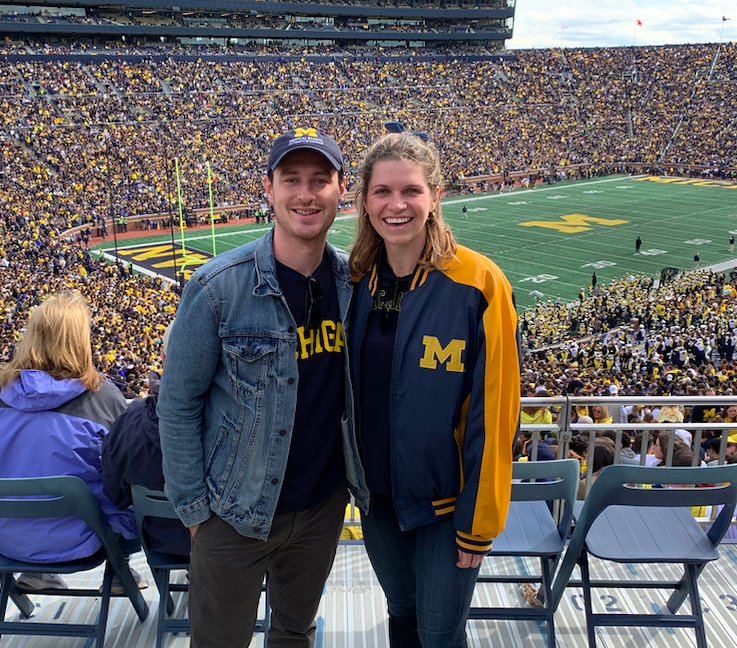
Go Blue!
From the student, Matt:
Now that we’ve been here for a few months, I can look back on the choices that have made the biggest impact so far. One that has been especially helpful is my flexible quiz schedule. At Michigan, we take a quiz every two weeks that covers the previous two weeks’ material. The quiz helps us solidify our understanding of the material in a lower-stakes environment. Students can take the quiz from Friday night through midnight on Sunday at their convenience. This flexibility is nice, but without proper planning your weekends can become filled with studying instead of taking a much-needed break and spending time with your partner. At the outset, I decided that I would always take the quizzes on Friday night. This has allowed us to spend the weekends together (with a bit of light studying mixed in). It’s been so freeing to not have a quiz hanging over my head on the weekend. Being a self-enforced rule, there are times mid-week where I don’t feel fully prepared for a Friday quiz, but I’ve somehow managed to keep to my Friday rule. Michigan does allow a re-take of a different version of the quiz on Monday called remediation quizzing, which replaces your other quiz grade if you score better. Having the option to re-take the quiz on Monday lowers the pressure of the first quiz and has allowed me to learn from my mistakes on Friday’s quiz.
Another important aspect of our curriculum is the ability to stream lectures. This has allowed me to spend more time studying from our home, which works well since Patty works remotely. As for the content, streaming offers the ability to pause and re-watch components of the lecture and take notes at a pace that is appropriate for me. Studying from home lets us have breakfast and/or lunch together on days when I don’t have required events on campus. This lets us see each other more during the week. Even if your partner doesn’t work from home, it’s thoughtful to prioritize being home for at least one meal of the day to share with each other. The gradual accumulation of dedicated meals each day or week, regardless of how spectacular (or not) each one may feel, leads to greater feeling of closeness, especially when studying can feel all-consuming.
In terms of friends, we’ve both tried to establish independent lives and social circles. Patty has encouraged me to attend medical school social events without her, even if that means not being home some evenings. The students in your medical school class will be the people that you study and work with for the next four years. They make you feel less alone during the grueling periods of study. Both partners need to be OK with building up your networks separately from one another. In addition, your partner should try to develop their own network of friends because your medical school friends are likely just as busy as you, and that only escalates during the clinical years. Luckily, Patty has found a community with her water polo team. I encouraged her to seek out a community based on her interests, so that when she shows up, there are already built-in commonalities and shared experiences.
From the partner, Patty:
Supporting a partner in medical school requires patience and understanding that school is the number one priority. This acknowledgement is easier to stomach knowing that medical school lasts four to five years, while your relationship together is lifelong (I hope!). Being willing to support your partner through this time period is essential. In many ways, we’ve felt the schoolwork taking over our relationship in the past year. Meals, social events, and working out needs to be planned around it. Because of this, it can feel like you are always short of time with each other. We’ve tried our best to push away this feeling, as it gets in the way of being able to spend time pursuing independent aspirations. The happiest times of our life together (so far) have been moments when all the chips have fallen into place — when we’ve had a network of good friends, well developed hobbies, athletic outlets, and each other. Moving to Ann Arbor, we had each other as a guarantee, but that was about it. We both needed to find new friends, find ways to pursue our hobbies, and discover new fitness routines. Michigan Medical school offers all of these things for a student, but what about a partner who is along for the ride?
Early on, we acknowledged that this was something that could make or break our happiness. While Matt joined in on the activities laid out for him in school, I threw myself into anything I could find – saying “yes” to as many things I could. Pushing away the awkwardness and discomfort is challenging, but I felt that at 26, if I couldn’t move to a new city and make a life for myself, then I never would be able to. To my surprise, the “yes” strategy started working. I joined the Ann Arbor Master’s Water Polo team, which I was elated to find (it’s incredible that Ann Arbor has its own team!) and said “yes” to the tournaments in Toronto, Chicago, and Seattle. I downloaded Bumble BFF and found so many other women in similar situations to me. The friend dates that I went on were a lot of fun. I joined a networking group for women in tech roles, and after dragging myself to the first meeting, I made an amazing new friend! Setting yourself up for success needs to come along with the dedication to your partner.
Things to do together:
As folks who have jumped around the East Coast and New England for our whole lives, we were initially hesitant about Ann Arbor. Neither of us had ever been to the state of Michigan before. It was helpful for us to admit our privileged past openly — Ann Arbor is not the same as New York or Boston. Once we acknowledged that, we were opened up to see all the incredible things that this place has to offer. In many ways, we’ve been able to do more of the things we love in Ann Arbor than we did in Boston. Patty’s water polo team and watercolor painting classes didn’t exist in Boston (at least not affordably). We live around the corner from the Kerrytown Farmers Market, which is something we’ve never had access to in a big city. We are able to drive around without traffic — an understated benefit. In the summer, we visited local farms for sunflowers, pumpkins and hay rides. In the winter, we’ve attended basketball games and visited museums on and off campus. In any season, downtown Ann Arbor offers more restaurants than your wallet will allow.
Since we try to spend one full day on the weekend together, we are always looking for the next new place to explore. We’ve loved exploring Detroit and taking photos of the beautiful architecture. Detroit is filled to the brim with interesting restaurants, history, museums, and shops that showcase passion and flair of the Motor city. On our way in or out of Detroit, we’ve made pit stops in Dearborn for Middle Eastern food or at the Henry Ford Museum, which boasts a spectacular display of planes, trains and automobiles.
The one thing you should take away from reading this is to discuss priorities and set expectations. Despite feeling like you both are on the same page, there is a good chance that you and your partner have different expectations of what medical school will require, what your lives will look like, and what will be expected of each of you to help the partnership work. Discussing your thoughts, feelings, and hopes in this regard is absolutely essential and should be talked about as openly as possible, as vulnerable as it may feel. Disappointment and hardship often come from a mismatch between expectation and reality, so calibrating those expectations can lead to a much happier and fulfilled life for you and your partner. We both wish you all the best here at Michigan and we know you’ll love Ann Arbor as much as we do!
by Jessica Santos-Parker | Mar 19, 2020
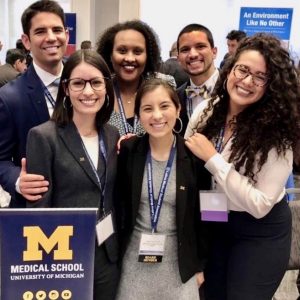
Changing the face of medicine at LMSA
A few weeks ago, I was grateful to attend the Latino Medical Student Association (LMSA) National/Midwest Regional Conference at Washington University School of Medicine in St. Louis, Missouri. This conference came at a perfect time in the middle of my third year as a medical student at the University of Michigan (UM), and has been one of many events during medical school that have strengthened my sense of community, recharged and inspired me, and reminded me of why I came to medical school.
I have always been told college is where I belong, yet through my experiences I have been struck by how important it is to find mentors and community that can provide support for the journeys that lie ahead. I am the granddaughter of Mexican immigrants. My mother walked across her high school graduation stage four months pregnant with me. My father served in the Navy and I lived in nine different houses before I graduated high school. I am the first in my family to attend college. Like many first-generation college students, once I achieved the dream of college, I was left with the question of “where do I go from here?” I realized no one had ever asked me what I wanted to be when I grew up and I had no insight into navigating higher education. Looking back, I realize I missed many opportunities. Thankfully, I followed each of my passions as I encountered them, discovering a love of anatomy as a senior in undergrad that led to a Master’s in Anatomy. My first research experiences in my master’s program drove me to a PhD in Integrative Physiology, and my desire to help patients led me to medical school. Even with all of the lessons I learned through my previous education, medical school has still felt daunting and at times I’ve felt lost on how to navigate all of these novel experiences.
However, I’ve found that having a sense of community has truly helped ground and revitalize me. Throughout my time in medical school, I have loved game and movie nights with the Latin American Native American Medical Association (LANAMA), going to conferences with passionate people, including LMSA or surgical conferences, mentoring first generation and women medical students and undergraduates, serving as co-director of the UM Student-Run Free Clinic, coaching track and field for first-sixth graders in Ypsilanti, and co-founding the Leadership Exposure for the Advancement of Gender and Underrepresented Minority Equity in Surgery (LEAGUES) Fellowship: an initiative to provide early surgical experiences for underrepresented minority medical students. Spending time with my community, whether in a social environment or working together to bring forth change, re-centers me on why I came to medical school – to be a leader and advocate for others and my patients.
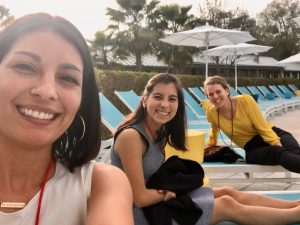
Friends poolside at the Academic Surgical Congress
The third year of medical school is an exciting and liberating time – you’ve taken Step 1 and have the freedom to personalize your schedule – explore rotations you’re interested in, perform research you’re passionate about, and pursue any opportunities you can think of. It’s also a time when your peers are scattered across different rotations and sometimes you can feel disconnected from your classmates. But many opportunities throughout the year do bring you together. So far I’ve been able to attend multiple conferences: Society of Thoracic Surgeons, where I was paired with inspiring women Cardiothoracic resident and surgeon mentors; Academic Surgical Congress where I presented my research, and heard passionate and inspiring talks about improving the future of surgery for patients and medical professionals; and the Moses Gunn Research Conference hosted by our Department of Surgery, where I presented my research and felt motivated by our surgical department to change the world through research.
The LMSA National/Midwest Regional Conference in particular was a beautiful conference that lasted three days where I was able to catch up with my peers and hear about everything in their lives, from the amazing things they are doing, to their rotations, exciting research, or submitting their match rank list! The days were filled with talks and presentations by the AAMC President, faculty, residents, and our peers that ignited conversations on advocating for ourselves and patients to change medicine and provide not only access to care but quality care for all. My fellow UM third year medical students, Gracia Vargas and Maria Santos, poured their hearts and souls into organizing the conference and their passion was evident!
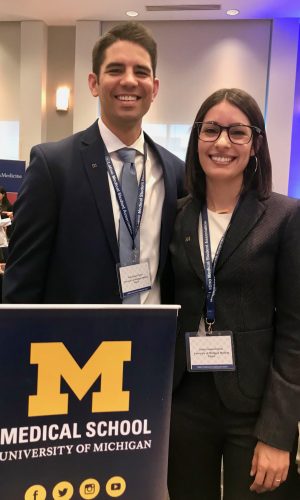
Grateful for my husband and I to be side by side on this journey
One thing I value about Michigan is the amount of support they provide their students. There was great UM representation at our exhibitor booth: medical students tabling for our medical school Admissions office, the UM Office for Health Equity & Inclusion sharing the opportunities at UM for students passionate about diversity and health equity care, and the Surgery Department, representing strong with our attending surgeon Dr. Filip Bednar and inspiring residents Valeria Valbuena and Shukri Dualeh sharing about the surgery department and great initiatives for underrepresented minority medical students, including LEAGUES and an away sub-Internship. These amazing surgeons spent one-on-one time teaching surgical skills, like knot tying, suturing, and laparoscopic skills to conference attendees.
The last night of the conference fittingly ended dancing into the night to Latin music with my husband and our friends. The conference strengthened that we are changing the face of medicine and that is something I am grateful to do with amazing fellow medical students, residents, and faculty at Michigan. I am most thankful to experience everything medical school (and life) has to offer, including the LMSA conference, with my husband, who is also a third-year medical student and has been my best friend and constant support. ❤️
¡Si Se Puede!
by Connie Thanapuasuwan | Feb 20, 2020
This past weekend, four of my M1 classmates and I had the wonderful opportunity to attend the 2020 APAMSA Region V Conference – Finding Your Voice hosted by the APAMSA chapter at the Ohio State University College of Medicine! The Asian Pacific American Medical Students Association (APAMSA) is a national organization that brings together medical and pre-medical students across the U.S. through local, regional, and national events. The organization’s mission is to promote the health of the Asian and Pacific Islander American (APIA) community and to address issues that disproportionately affect APIA individuals while serving these populations in a culturally sensitive manner.
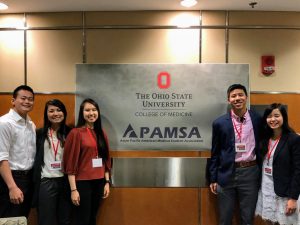 Shannon Jiang, Curtis Kuo, Daniel Yang, Angela Yim, and I represented the UMMS chapter of APAMSA, also known as the United Asian American Medical Students Association (UAAMSA) here on campus. We made the three-hour drive to Columbus, Ohio last Friday afternoon, and had the chance to get to know each other even better than we already had through some fun conversations on the car ride and throughout the weekend. When Saturday morning came around, we headed off to the incredibly beautiful Ross Heart Hospital for the conference, and met several medical and pre-medical students from all across the Midwest region. First, we heard from State Senator Tina Maharath, the first Asian-American woman ever to be elected to the Ohio Senate. She overcame great adversity as the daughter of Laotian refugees, and she is now tremendously involved in her community and advocates for diverse representation in politics. I was then mesmerized by Dr. Peter Lee, a practicing cardiothoracic surgeon who impressively merged his various passions including Tae Kwon Do and space into his career path in medicine and research. He pursued degrees at various institutions including the International Space University, and he has flown several microgravity and spaceflight projects with support from the NIH and NASA (so cool!).
Shannon Jiang, Curtis Kuo, Daniel Yang, Angela Yim, and I represented the UMMS chapter of APAMSA, also known as the United Asian American Medical Students Association (UAAMSA) here on campus. We made the three-hour drive to Columbus, Ohio last Friday afternoon, and had the chance to get to know each other even better than we already had through some fun conversations on the car ride and throughout the weekend. When Saturday morning came around, we headed off to the incredibly beautiful Ross Heart Hospital for the conference, and met several medical and pre-medical students from all across the Midwest region. First, we heard from State Senator Tina Maharath, the first Asian-American woman ever to be elected to the Ohio Senate. She overcame great adversity as the daughter of Laotian refugees, and she is now tremendously involved in her community and advocates for diverse representation in politics. I was then mesmerized by Dr. Peter Lee, a practicing cardiothoracic surgeon who impressively merged his various passions including Tae Kwon Do and space into his career path in medicine and research. He pursued degrees at various institutions including the International Space University, and he has flown several microgravity and spaceflight projects with support from the NIH and NASA (so cool!).
Afterwards we had several breakout sessions including a resident panel, a leadership workshop, and a discussion on breaking the APIA mental health stigma. One of the panelists that spoke to us is currently a general surgery resident who graduated from the University of Michigan Medical School and actually started the Medicine in Mandarin course that over a dozen of my classmates participated in this year! Another session featured Dr. Ron Jacob, a former Be The Match Executive Director, who addressed the inequality of available life-saving blood, stem cell, and marrow donors for ethnically diverse patients. And the last breakout session featured a dermatologist and a facial plastic surgeon who shared their personal stories and achievements (lots of words of wisdom). Finally, to end the conference, we heard from two women who have dedicated much of their lives to building strong communities through leadership in community-based Asian organizations that strive to address health concerns within the Asian population in Ohio through free clinics and local screenings.
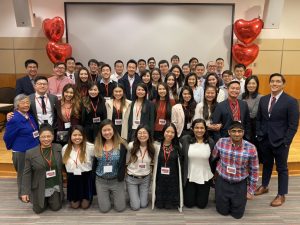 I was thoroughly fascinated by each of the speakers and all the stories that they shared! The marvelous thing about conferences (for me, at least) is their power to inspire and reinvigorate my passion for medicine. I love having the chance to get out of the library and Ann Arbor for a weekend so I can meet and make connections with medical students at other institutions while learning about their experiences, be reminded of the importance of giving back to the community particularly in the context of health care, and hear about the roller coaster of a journey that successful practicing physicians have lived through.
I was thoroughly fascinated by each of the speakers and all the stories that they shared! The marvelous thing about conferences (for me, at least) is their power to inspire and reinvigorate my passion for medicine. I love having the chance to get out of the library and Ann Arbor for a weekend so I can meet and make connections with medical students at other institutions while learning about their experiences, be reminded of the importance of giving back to the community particularly in the context of health care, and hear about the roller coaster of a journey that successful practicing physicians have lived through.


 Since being dismissed from the clinical space, my classmates and I have been mobilizing to address some of these gaps and support our disrupted community. We have become babysitters for physician residents and grocery shoppers for our elderly neighbors. We have been calling local home improvement stores to collect PPE and staffing blood drives and COVID-19 hotlines. We even made our own bottles of hand sanitizer from scratch and assembled hundreds of sack lunches in a classmate’s apartment for distribution at local homeless shelters. Medical students may not be allowed on the front lines, so for now we have assumed a role on the home front, serving and organizing at a distance, awaiting the day when w
Since being dismissed from the clinical space, my classmates and I have been mobilizing to address some of these gaps and support our disrupted community. We have become babysitters for physician residents and grocery shoppers for our elderly neighbors. We have been calling local home improvement stores to collect PPE and staffing blood drives and COVID-19 hotlines. We even made our own bottles of hand sanitizer from scratch and assembled hundreds of sack lunches in a classmate’s apartment for distribution at local homeless shelters. Medical students may not be allowed on the front lines, so for now we have assumed a role on the home front, serving and organizing at a distance, awaiting the day when w







 I was thoroughly fascinated by each of the speakers and all the stories that they shared! The marvelous thing about conferences (for me, at least) is their power to inspire and reinvigorate my passion for medicine. I love having the chance to get out of the library and Ann Arbor for a weekend so I can meet and make connections with medical students at other institutions while learning about their experiences, be reminded of the importance of giving back to the community particularly in the context of health care, and hear about the roller coaster of a journey that successful practicing physicians have lived through.
I was thoroughly fascinated by each of the speakers and all the stories that they shared! The marvelous thing about conferences (for me, at least) is their power to inspire and reinvigorate my passion for medicine. I love having the chance to get out of the library and Ann Arbor for a weekend so I can meet and make connections with medical students at other institutions while learning about their experiences, be reminded of the importance of giving back to the community particularly in the context of health care, and hear about the roller coaster of a journey that successful practicing physicians have lived through.